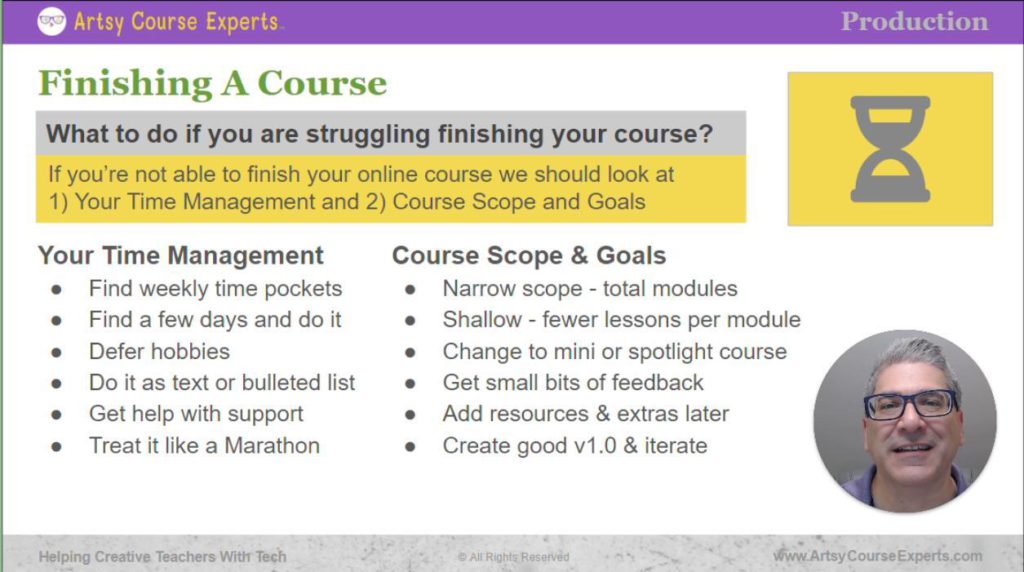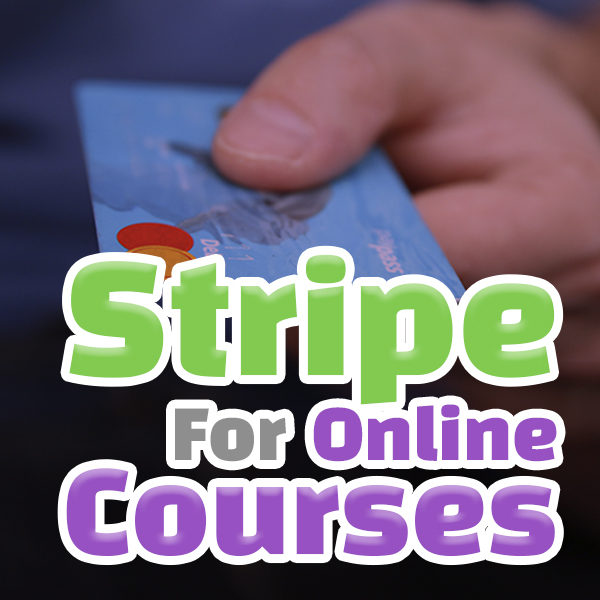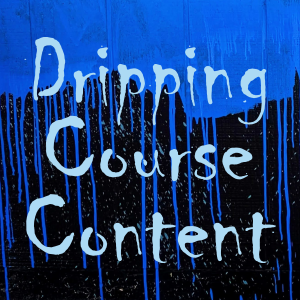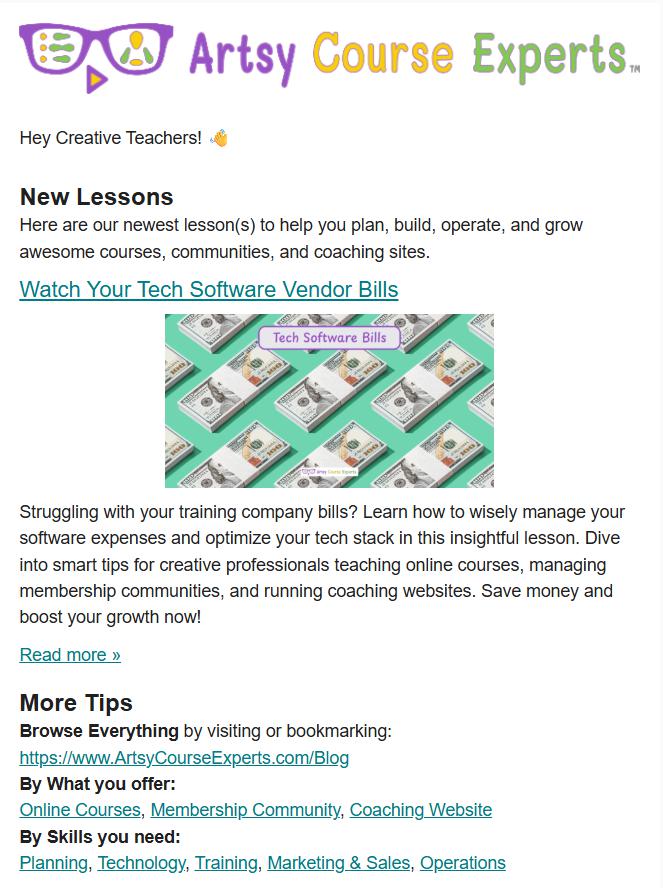Creating an online course is one way of sharing your expertise and earning money. You may have even promised your community an online course, and now you have to keep to your word. However, even with a little accountability pressure, you may still find it difficult to finish your course, which can be frustrating.
The truth is, creating an online course is a big deal. You’re doing something hard and amazing, so it’s okay if you want it to come out great and it takes a while to come together. Don’t worry, you’re not alone. Teachers and creators often struggle with finishing a course they have started, that’s why we’ve created this lesson on finishing an online course.
Problems online course creators can face if they don’t finish their course:
- You may not achieve your new income goals
- You won’t be known on the Internet for your area of expertise
- You may burnout and give up if you don’t make progress
- You may not seem accountable if you promised to deliver this course
- You may have to return any pre-sales money you received
- You may not get to create other profitable services like coaching and communities
Video Lesson – How to Finally Finish Your Course
What To Do If You Are Struggling To Finish Your Course?
Let’s look at some of the main reasons you’re not finishing your online course. They fall into two categories. First is your time management, and the second is your course target scope.
Time management is about finding pockets of time to get your work done. Maybe there’s a lot of work to do. When will you find quality time to do that? Secondly, scope and goals are about what you’re trying to do, your target, and your vision. Is it too wide to achieve, or is it concise that you can achieve it within a reasonable time?
We’ll discuss how time management and scope can help you finish your online course.
Time Management For Course Creation
Time management is the process where people organize and plan different activities.
The goal is to allocate the right time to prioritize activities like steps to complete your course.
In time management, you not only want to complete your daily tasks like filming a lesson but also your longer goals like finishing and publishing your course.
Find Weekly Time Pockets
Weekly time pockets can help you manage your time and create a window of time for your courses. For example, you can schedule 4 hours every Saturday morning or 2 hours every Wednesday night. You just have to put in the right amount of time that will help you get the work done without overwhelming you.
It would help if you set a reminder on your calendar and let everyone around you know that you will be working on your course at this particular time slot. That way, they can give you time and space to work on your course and also hold you accountable for achieving this goal using social pressure.
Find a Few Days and Do It
You can find out a few days and dedicate those days to finishing your online course. It could be Christmas break, spring break, or a long holiday weekend when you take a break from Friday to Sunday.
Maybe you don’t have any big plans, and you control yourself from looking for something else to do during your free time. This would be an ideal time to spend the whole weekend getting your course 90+% done. Imagine how happy you’ll be after that focus session gets you to version 1 of your course.
Defer Some Hobbies
Another time management technique is deferring your hobbies. This simply means adjusting the time you spend on your hobbies to accommodate your online course goals.
Maybe you’re spending hours a week binge-watching your favorite series or hours watching every sports team. Consider skipping one season of your show or only watching on Friday or Sunday nights. Then, once you’re done with your course, you can come back and catch up on endless hours of TV.

Do It as a Text Dump or a Bulleted List
Dumping all your ideas as raw text or a bulleted list can help you quickly create the content for your online courses.
Maybe you’re trying to create every single slide, bullet point, and video in detail. You can try taking it up a notch and creating just the outlines, then arrange your modules and go over each lesson.
It doesn’t have to be pretty, you just have to put it down on paper and add your notes.
It also doesn’t have to be full paragraphs or grammatically correct sentences either, consider typing a couple of words or one giant sentence for each lesson. Before you know it you’ll have the main point for all your lessons done, and then you can do another round to polish and format.
Either way, a good tactic is to get all your main ideas out as text or bullets, and then do another pass to polish and finish.
Get Help with Support
Getting support goes a long way toward helping you finish a course online.
You could have the curriculum outlined, but you need help with creating pretty lesson slides for your courses.
Or you have the class videos recorded, but you’re not good at editing. It’s okay if it’s not your thing. You can easily get help with editing your videos.
And even at the end, you may be done with polished videos but still need help uploading the courses and curriculum to a system like thinkific or teachable. You can find an e-learning tech service like ArtsyCourseExperts that will help you prepare and upload your content to a course system.
Treat It Like a Marathon
The last time management approach on the list is to treat finishing a course similar to finishing a marathon.
If you want to achieve something really big, you can’t achieve it in a weekend or a short period, it will take a while. It would be easier if you had cadence and worked mile by mile, just like a marathon – it’s not a sprint!
Your course may be a long course, but if you’re convinced that this big goal is the right one – just keep working on it, and keep taking steps towards that goal until you reach the finish line.

The Scope And Goals For An Online Course
After utilizing one or more time management approaches, the next thing to do is to think clearly about what you’re trying to do.
Are you trying to run a giant marathon or a smaller 5k? What target are you going after?
Let’s review some tactics that can help you define and refine your course scope and specific goal.
Narrow Scope
One thing you can do if you are struggling to finish is to narrow your scope.
This means narrowing the course to what you can handle and completing the work. You may have planned 27 modules when 10 modules are enough to get your first course done.
Remember each lesson has phases such as lesson topics, slides/materials, videos, and supporting resources. Regardless of whether you focus on phases of work or lesson by lesson – if you aren’t making progress, you may have too many lessons.
By narrowing your scope and reducing the total number of lessons, you can start to get through the phases faster to complete a more significant percentage of the course each week.
Shallow – Fewer Lessons per Module
The next option to help you go faster is to create a shallow course.
You could aim for fewer lessons per module, so instead of going deep on each module, you cover just the most important items in each module.
- Before: 10 Modules with 5-7 Lessons each
- After: 10 Modules with 3 Lessons each
This helps get the modules done efficiently, and you will see real movement as you complete the modules.
Reduce To Mini or Spotlight Course
Another option is narrowing your vision. You may have started out with a grand idea of creating the ultimate masterclass, which will consume more time and energy and could force you to give up.
A mini course is great, especially because you’ll finish it faster and get going. Knowing you’re working on a mini course instead of a masterclass will reduce the pressure on you to get the job done. Think of a mini-course like a primer or introduction for new or junior writers, makers, or designers.
It could also be a spotlight course on a special subtopic in your field, and that’s okay. You can reframe it into an online course, put it out there, and get students to your course. The spotlight course is narrow but deep – like learning how to add different kinds of echos to your podcasts and music using the Audacity application. That’s way more achievable than trying to teach Audacity or teach all the popular audio effects in the market.
Get Course Feedback
Getting feedback from an existing customer base, social following, or friends and family can help you finish your course.
If you have some videos, slides, or PDFs, you can use one content item to get feedback. Ideally, it’s a piece of content from your new course, but it could also be a blog article or YouTube video that you are testing to see if it resonates and helps your community.
Getting feedback will help you know what your students are thinking. For example,
- This is helpful
- There is too much jargon
- You skipped over an important step
Even if the feedback is negative, you can still learn from it. You may learn that your topic is desired but your sample files are hard to use or your camera angle is not helpful.
In the end, all feedback is good. It will give you confidence or push you toward completing the right content for your course.
Add Resources and Extras Later
You may have the course lessons done but still, feel like you don’t have it all together. Since a full-on professional online course usually has pdfs, samples, bonus materials, surveys, and quizzes.
But don’t let that stress you out. The good news is you can do these later. It is possible for you to launch your initial course without all these extras.
However, if you feel your course isn’t up to par without these extras – you can start with a very simple survey with 1 question, a quiz with 3 multiple choice questions, or a 1-page google document that you export as a PDF.
So to get done faster – skip extras or go for a lean extra. This will reduce your scope so that you can focus on the baseline content and get your work done!
Create a Version 1.0 and Iterate
You can try the option of creating version 1.0 of your course. Think of it like a piece of software with just a few features or a limited electronic toy with just a few buttons, lights, and sounds.
Iterating allows you to launch your course and improve it over time.
Using iterations will give you time to:
- Use money slowly
- Create better videos
- Learn which problems to teach
- Create better designs and layouts
- Buy better equipment
Frequently Asked Questions

Summary – Finishing Your Online Course
These are the techniques that can help you finish your creative course in design, making, fashion, writing, or whatever your content is about.
First of all, double-check your time management. When are those windows of time that you’ve set aside to get work done? Reserve it and prioritize it. Call it out and tell people that I’m working on my course at this time.
Secondly, pick out the right vision and set your target for your goal. Getting something done at an OK quality is way better than being stuck at not done month after month. You could call it a mini course or even a free course. Just try and get that first or next course into the market, get students to go through it, and you’ll learn so much by actually getting to the finish line.
Hopefully, this lesson has given you some ideas on how to finish your online course.
Here are some final tips to help you finish your online course:
- Manage your time properly, set a timetable, and stick to it
- Organize your workspace, and make it conducive for working on your course
- Be committed and dedicated to creating and finishing your course
- Don’t get carried away by complexity, use basic tools and get going.
- Find a mentor, someone that inspires you to create courses (PS have you subscribed to our email?)
- Find an accountability partner, and think of who you can be accountable to about finishing your course
- Start small, limit your scope to what you can handle
- Take care of your health. A healthy mind and rested body set you up for success
For more creative teacher help building, operating, and growing your online courses, check out our ArtsyCourseExperts blog and subscribe to our email for regular tips.
More Tips For Online Teachers
The following lessons can also help you with finally finishing your online course:
- Planning New Online Courses Using SWOT Analysis
- Microlearning – Teaching One Small Thing Per Lesson
- Diversity, Equity, and Inclusion (DEI) For Online Course Creators
- Creating An Online Course – Welcome Video
- How To Create A Guide For Your Online Course?
- Using Canva To Create Quick Lesson Illustrations
- Video Hosting Options For Online Courses
- Teaching Creative Online Courses Using Drip Feeding
- Checking The Quality Of Your Online Course Lessons
- Use Care When Searching For Course Images
- Onboard New Students With A Welcome Email











